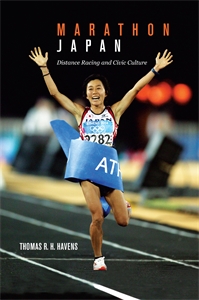Marathon Japan: Distance Racing and Civic Culture
- About the Book
-
Japanese have been fervid long-distance runners for many centuries. Today, on a per capita basis, at least as many Japanese residents complete marathons each year as in the United States or any other country. Marathon Japan is the first comprehensive English-language chronicle of the history of this important part of Japanese sports culture. It traces the development of distance racing beginning with the Stockholm Olympics of 1912, when the Japanese government used athletics, and above all the marathon, as a means to continue its late nineteenth-century project of winning the respect of Western countries and achieving parity with the world powers. The marathon soon became the first event in a Western-derived sport in which Japanese proved consistently superior to athletes from other countries. During the 1920s and 1930s, Japanese runners regularly produced the fastest times in the world, and twice in the period after World War Two—in the 1960s and late 1970s–1980s—Japanese men again dominated world marathoning. Japanese women likewise emerged as some of the world's fastest in the 1990s and early 2000s. Meanwhile the general public took up distance running with enthusiasm, starting in the 1960s and continuing unabated today, symbolized most recently by massive open-entry marathons in Tokyo, Osaka, and other Japanese cities comparable in scale and challenge to major world races in Boston, New York, Chicago, London, and Berlin.
In this book, Thomas Havens analyzes the origins, development, and significance of Japan's century-long excellence in marathons and long-distance relays (ekiden), as well as the reasons for the explosive growth of distance racing among ordinary citizens in more recent decades. He reveals the key role of commercial media companies in promoting sports, especially marathons and ekidens, from the 1910s to today and explains how running became a consumer commodity beginning in the 1970s as Japanese society matured into an age of capitalist affluence. What comes to light as well are the relentlessly nationalistic goals underlying government policies toward sports—above all marathons, where Japanese have been so successful—throughout the modern era. The public craze for distance racing, both watching and running, has created a shared citizenship of civic participation among young and old, male and female, persons of every social background and level of education. The combination of speedy elite athletes and huge numbers of general-citizen runners means that Japan today is truly a marathon nation.
Marathon Japan will appeal to Japan specialists interested in modern cultural and social history. It will engage recreational runners in Japan and abroad as well as anyone interested in the history of sports.
- About the Author(s)
-
Thomas R. H. Havens, Author
Thomas R. H. Havens is professor of history at Northeastern University.
- Reviews and Endorsements
-
- Havens (Japanese history, Northeastern Univ.) tackles a sport often overlooked by those studying sport in Japan. . . . A must read for anyone interested in Japanese sport and its role in the larger Japanese society.
—Choice - Havens succeeds most in providing a plethora of very readable information about marathon athletes and coaches, the popular races, and running as a participant sport in general.
—Japanese Studies - Readers strongly interested in Japanese marathons and in ekiden will find many remarkable details in Havens’s book, including information concerning male and female runners of various social backgrounds and age groups, as well as those with disabilities.
—Monumenta Nipponica - It is the genius of Havens’s approach to juxtapose the marathon with the ekiden and to connect elite distance running with the boom in popular recreational running. In doing so, he demonstrates the multiple ways of being citizen-runners in Japan. . . . Havens is particularly insightful in showing the consequential trade-offs of a national running scene based on these two rather different forms, which is an unusual combination among leading running countries.
—Journal of Japanese Studies
- Havens (Japanese history, Northeastern Univ.) tackles a sport often overlooked by those studying sport in Japan. . . . A must read for anyone interested in Japanese sport and its role in the larger Japanese society.
- Supporting Resources
-










